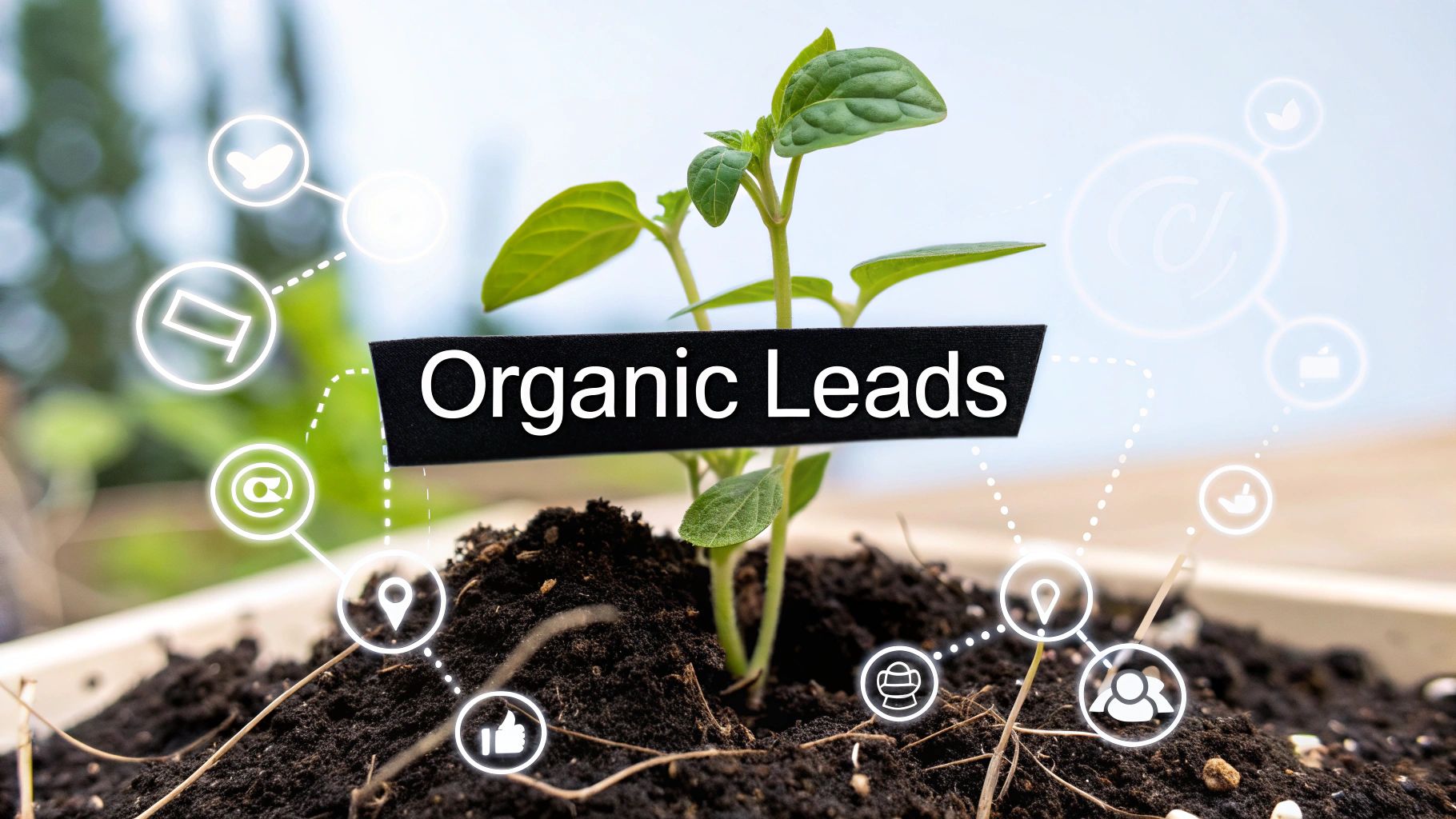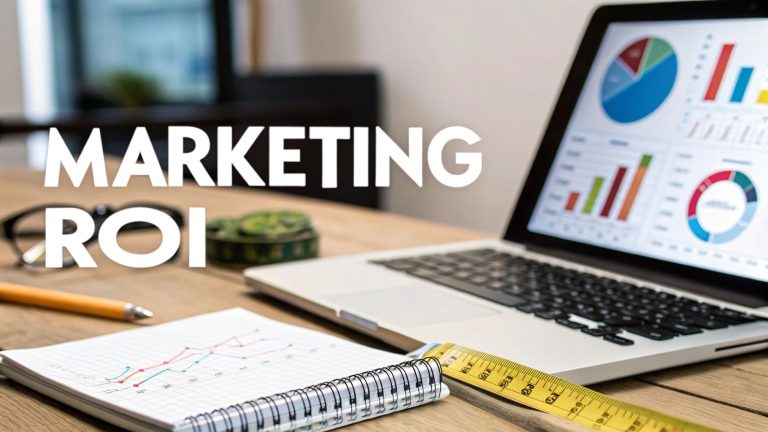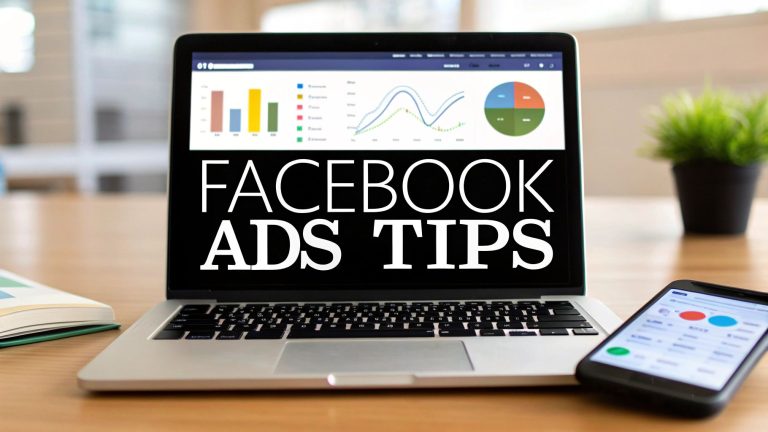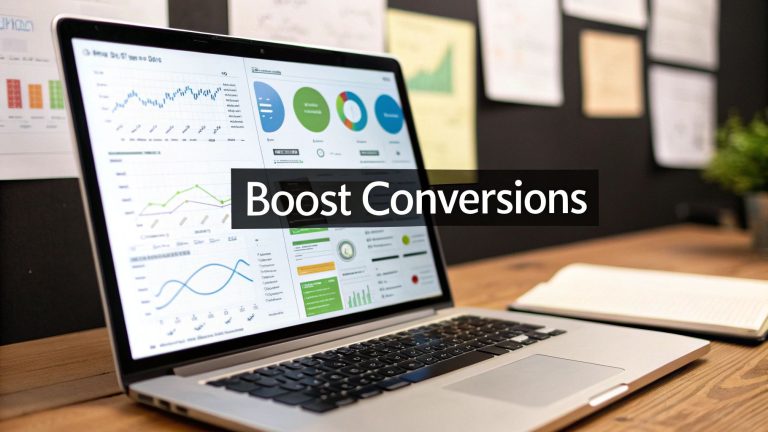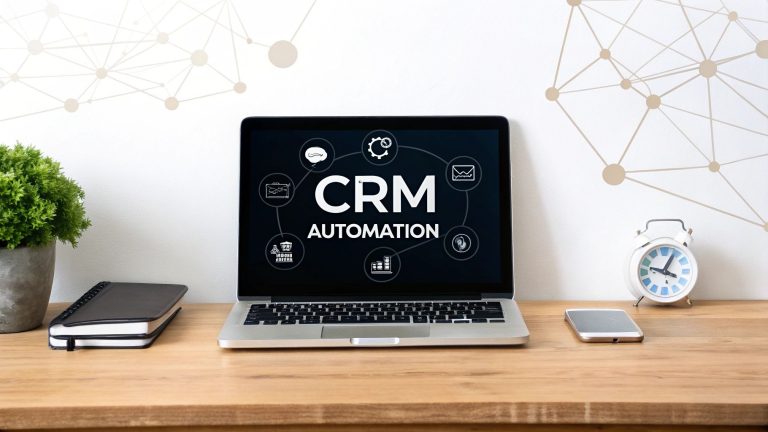Sustainable Organic Lead Generation Guide
Let's be honest, when most people hear "organic lead generation," they just think "free leads." And sure, not paying for ads is a nice perk, but seeing it that way misses the entire point. It's not just the "free" alternative to paid ads; it's a completely different, and frankly, more powerful way to build your business.
Building an organic engine means you're creating genuine authority and fostering a level of customer trust that a paid ad just can't buy.
Why Organic Leads Are Your Most Valuable Asset
Think about it this way: paid leads are rented. The moment you turn off the ad spend, the leads dry up. Poof. Gone.
But organic leads? You own those. The system you build—through helpful content, smart SEO, and real engagement—becomes a business asset that works for you 24/7, generating value long after you hit "publish."
Fostering Trust and Authority
Every single piece of content you create is a brick in your authority wall. Each blog post, every keyword you rank for, every helpful answer you give in a forum—it all adds up.
When a potential customer Googles a problem and finds your in-depth guide, you've already won half the battle. They came looking for an expert, and they found you. This relationship starts with you providing real value, not with you asking for a sale. That's a game-changer.
"Organic leads are the byproduct of being genuinely helpful at scale. When you consistently solve problems for your audience, they naturally gravitate toward your brand, creating a resilient customer base that isn't dependent on fluctuating ad budgets."
Building a Resilient Business
Companies that lean into organic growth aren't just saving money; they're building a more stable, predictable business. They're insulated from the crazy swings in ad costs or the sudden algorithm changes that can tank a paid-only strategy overnight.
This isn't about one person's effort. It takes a dedicated team focused on creating this kind of value to generate a steady stream of high-quality organic leads, as you can see below.
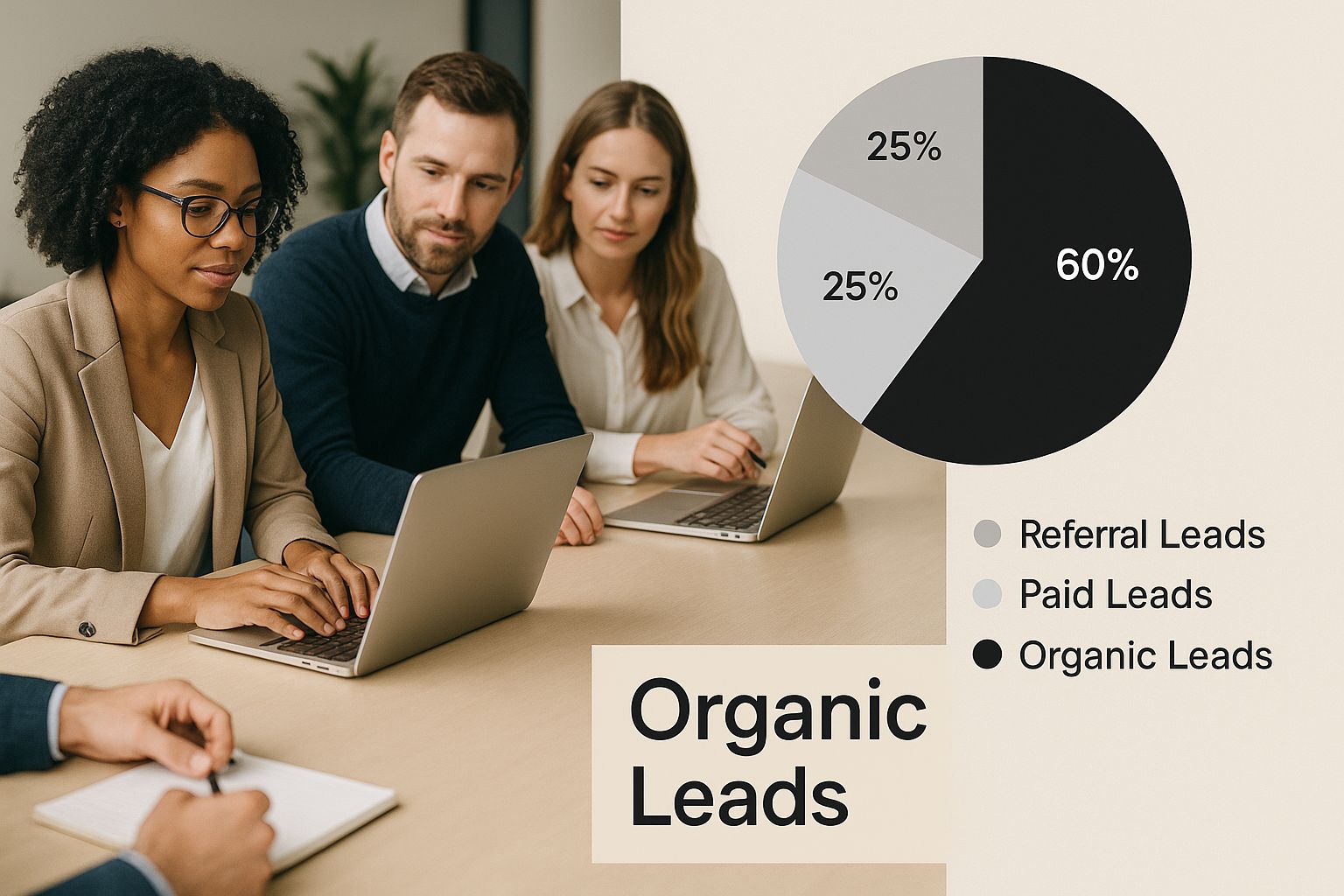
When your marketing, sales, and content teams are all rowing in the same direction, you create a pipeline of prospects who already trust you before the first sales call. It's a foundational piece for a sustainable, high-ROI machine. Yet, surprisingly, only 34% of marketers actually prioritize lead generation from their content.
To give you a clearer picture, let's break down the core differences between organic and paid approaches.
Organic vs Paid Lead Generation at a Glance
| Attribute | Organic Lead Generation | Paid Lead Generation |
|---|---|---|
| Cost | Low monetary cost, high time/resource investment | High monetary cost, faster initial setup |
| Time to Results | Slower to build momentum, can take months | Immediate results, but stops when you stop paying |
| Sustainability | High; creates a long-term, compounding asset | Low; dependent on continuous budget |
| Audience Trust | Very high; built on expertise and value | Lower; often viewed as an interruption or ad |
| Resilience | More stable and less affected by ad market volatility | Vulnerable to rising ad costs and platform changes |
Ultimately, while paid ads can give you a quick boost, a strong organic foundation is what creates lasting success.
Before jumping into the tactics, it's worth getting a bird's-eye view of the different organic marketing strategies available. Committing to an organic-first mindset isn't just a marketing decision—it's a business philosophy that will pay you back for years.
Building Your Content Engine to Attract Leads

Let's be real: your content is the engine that drives your entire organic lead generation strategy. It's the magnet that pulls your ideal audience in—not by shouting at them, but by offering genuine value.
Forget just chasing keywords. The real goal is to become the go-to resource people think of when they have a specific problem.
This all starts with knowing your audience inside and out. I'm not talking about basic demographics. You need to dig deep and find out what really keeps them up at night. What are their biggest headaches, and what solutions are they desperately Googling?
When you answer those questions, you can create content that clicks on a personal level. People will actually want to connect with your brand.
Aligning Content Formats with the Buyer's Journey
Not all content is created equal. A huge mistake I see people make is throwing random blog posts out there and hoping something sticks. You have to match your content format to where your prospect is in their decision-making process.
Someone just realizing they have a problem needs something completely different from someone who's ready to pull out their credit card.
Think about it in these stages:
- Awareness Stage: The person knows they have a problem but might not have a name for it yet. They’re using broad, problem-focused search terms. This is where top-of-funnel content shines. Think in-depth blog posts, educational videos, and easy-to-digest infographics.
- Consideration Stage: Now they’ve defined their problem and are actively researching solutions. They're comparing different products and approaches. This is the perfect time for detailed case studies, comparison guides, and expert-led webinars.
- Decision Stage: The prospect is about to make a choice. They just need that final nudge to feel confident your solution is the right one. This is where product demos, free trials, and powerful customer testimonials do the heavy lifting.
By building out content for each stage, you create a complete journey that guides leads from "I have a problem" to "Here's my money."
Content isn't just about getting traffic; it's about building a relationship. Each piece should be a stepping stone, providing value and gently guiding the user toward a solution—yours. This builds trust long before a sales conversation ever happens.
Crafting Content That Converts
Creating killer content is only half the battle. If it isn't structured to actually capture leads, you're just running an educational charity. Every single piece of content needs a clear purpose and a next step for the reader.
For a deep dive on how to set this up correctly, check out this guide on building a powerful content strategy framework. A solid strategy ensures every article and video you produce directly serves your business goals.
Once you have someone's attention, you need a smooth way to turn them into a lead. This is where lead magnets and clear calls-to-action (CTAs) are crucial. A great CTA might offer a downloadable checklist, an exclusive ebook, or a seat in a webinar in exchange for their contact info.
This simple exchange turns passive readers into active leads. As these leads start rolling in, you need a system to manage them. Using a centralized lead generation dashboard lets you track every prospect and their source, ensuring no opportunity ever slips through the cracks. Find out more at: https://leadsavvy.pro/post/lead-generation-dashboard/
Mastering SEO for a Predictable Lead Flow
So you've created some killer content. That's a huge first step. But even the best article on the planet is useless if no one ever sees it. This is where SEO comes in—it’s the engine that gets your content in front of the right eyeballs.
Without a solid SEO strategy, you're just publishing into the void. With it, you turn your content into a predictable machine for organic lead generation.
This isn't about the old-school, spammy tricks like stuffing keywords everywhere. Modern SEO is all about proving to search engines that your content is the absolute best answer to what someone is looking for. It all boils down to understanding user intent—the "why" behind every search.
Think about it: someone searching for "CRM software features" is just browsing. But someone typing in "best CRM for small business" is getting ready to pull out their credit card. Your job is to target the search intent that aligns directly with your business goals.
On-Page SEO: Your First Line of Attack
On-page SEO is all about optimizing the stuff you can directly control on your website's pages. Every blog post, every landing page is another chance to bring in qualified traffic. It’s like setting the stage so both Google and your future customers know exactly what you’re offering.
Here's a quick checklist I run through for every piece of content I publish:
- Title Tag: Is my main keyword in the SEO title? It should be, and as close to the beginning as possible. This is a massive ranking signal.
- Meta Description: This is your free ad on Google's search results page. I write mine to be compelling and click-worthy, not just a summary.
- Clear Headings: I use a logical structure (H1, H2s, H3s) to break up the text. This makes it easy for people to scan and helps search engines grasp the page's structure.
- Internal Links: Are you linking to other relevant articles on your own site? This is key for spreading "link juice" around and keeping visitors on your site longer.
SEO isn’t a set-it-and-forget-it task. It's a constant process of tweaking and improving. The real goal is to become the most trusted, helpful resource in your space. When you do that, Google will reward you with a steady stream of high-quality leads.
Beyond the Page: Technical Health and Building Authority
Your on-page efforts are only half the battle. They need to be backed by a technically solid website and a strong reputation online.
Technical SEO is about making sure search engines can find, crawl, and index your site without any issues. The big three here are site speed, mobile-friendliness, and a secure site (HTTPS). A slow or broken website is a lead-killer. Period.
At the same time, you need to be building your site's authority with backlinks. Think of these as votes of confidence from other websites. When a reputable site links to you, they're vouching for your content. I always look for guest blogging opportunities or collaborations to earn these kinds of powerful links. A strong backlink profile almost always means higher rankings and more organic traffic.
Ultimately, all these pieces—on-page, technical, and off-page SEO—have to work together. The only way to know if your hard work is paying off is to track your results. To get a clear picture, you need to understand the key lead generation performance metrics that connect your SEO efforts directly to your bottom line.
Using Social Media for B2B Organic Leads
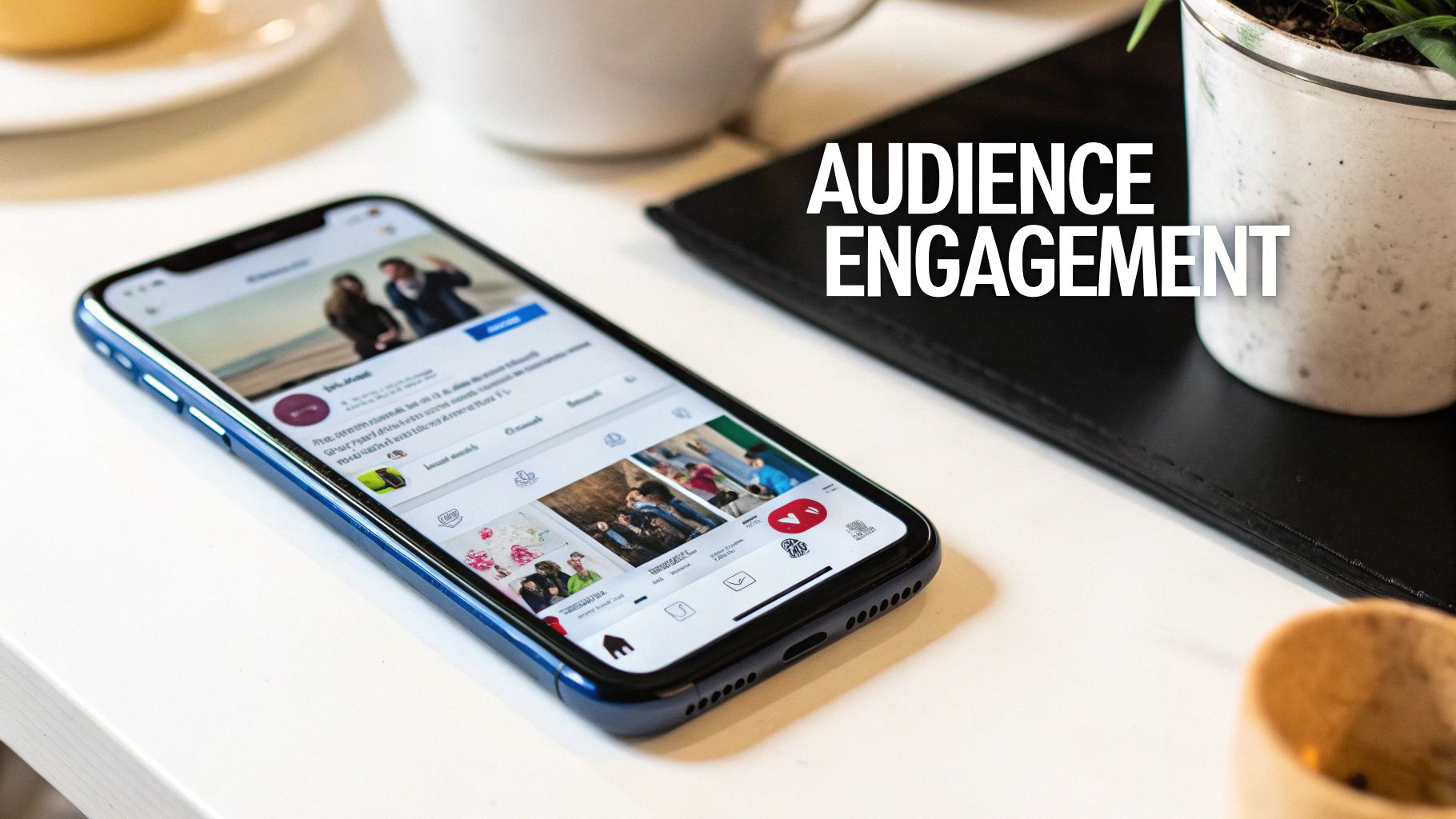
If you think social media is just for brand awareness, you're leaving a massive opportunity on the table—especially in the B2B world. When you know how to use them, platforms like LinkedIn aren't just digital billboards. They are active, dynamic environments perfect for organic lead generation.
The trick is to stop broadcasting and start connecting. It's all about building relationships and proving your authority through consistent, valuable activity. When you get this right, your social profiles transform into lead magnets that pull in inquiries without you spending a single dollar on ads.
Optimize Your Digital Handshake
Think of your personal and company profiles as the first impression a potential lead gets. Don't treat them like a resume. Instead, optimize them to speak directly to your ideal customer.
Your personal LinkedIn headline shouldn't just be your job title. It needs to be a clear, confident statement of who you help and how you do it. Instead of "Sales Manager at Company X," try something like, "I Help SaaS Founders Scale MRR with Data-Driven Sales Strategies." See the difference? One is a title; the other is a solution.
For your company page, use that banner image and "About" section to show off customer wins and your core value propositions. Make sure your services are clearly listed and link back to relevant case studies or landing pages on your website.
Social media success isn't about going viral. For B2B lead generation, it's about consistently showing up in the right conversations with the right people, demonstrating expertise until you become the obvious choice.
Turn Content Into Conversations
Just dropping links to your latest blog post is a surefire way to get ignored. To generate real engagement that leads to business, you have to repurpose your best content for the platform you're on.
Pull out a compelling statistic, a key quote, or a surprising insight and build a native post around it.
For instance, take one killer takeaway from a long-form guide and turn it into a short, scannable text post. End it with a question to get a discussion going. Or, transform a case study into a carousel post that visually walks people through the problem, your solution, and the incredible results.
This approach hits two critical goals at once:
- It drives real engagement: Comments and shares on native posts are far more valuable to the algorithm than a simple link click.
- It builds your authority: When you consistently share valuable insights, you position yourself as the go-to expert in your niche.
Leverage Native Platform Features
Modern social platforms, especially LinkedIn, are literally built for this stuff. LinkedIn is a powerhouse for organic B2B leads, with over 587 million visits from organic traffic recorded in 2024 alone.
Its native tools are incredibly effective. For example, LinkedIn Lead Gen Forms boast a 13% conversion rate, which is more than five times the industry average for typical landing pages. You can dig into more of these powerful stats on LinkedIn's lead generation performance.
Another powerful, no-cost strategy is getting active in relevant industry groups. Find the communities where your ideal customers are asking questions. Don't just jump in with a sales pitch. That's a fast track to getting booted. Instead, provide genuinely helpful, detailed answers.
When you become a trusted voice in these groups, you build incredible social proof. Before you know it, people will start seeking you out directly, creating a steady stream of warm, inbound leads who already see you as an expert.
Turning Website Visitors Into Qualified Leads
Getting a steady stream of traffic to your website is a fantastic start, but let's be honest—it's only half the battle. All the traffic in the world means nothing if those visitors just click away. This is where you shift from just attracting eyes to actually generating business.
We're talking about turning your website from a digital brochure into a powerful machine for organic lead generation. The idea is simple: make it incredibly easy and compelling for a visitor to say "yes." This isn't about tricking or pressuring anyone. It's about guiding them naturally toward becoming a lead because you've offered undeniable value.
Someone who found you through a search is already curious. Your job now is to prove that giving you their email address is the best next step they can take.
Designing Calls-to-Action That Actually Work
Your call-to-action (CTA) is the single most important bridge between a passive reader and an active lead. A weak, generic button like "Submit" or "Click Here" is a massive missed opportunity. It's lazy, and your visitors know it.
Effective CTAs are specific, highlight a clear benefit, and feel urgent.
- Instead of "Download Now," try "Get My Free SEO Checklist."
- Instead of "Subscribe," use "Join 10,000+ Marketers."
- Instead of "Contact Us," be more direct with "Request a Free Demo."
Don't forget the design. The button's color, size, and placement all play a part. It needs to pop visually without being obnoxious. A great rule of thumb is to place CTAs exactly where a user's eye goes right after they’ve consumed a key piece of information.
Creating Lead Magnets They Can't Resist
A lead magnet is your value proposition in action. It's the high-value goodie you offer in exchange for an email address. This is your moment to truly shine and show off your expertise.
A great lead magnet solves a very specific, urgent problem for your audience. It gives them a quick win and a taste of the incredible value your business provides.
The best lead magnets feel like they should have cost money. When a visitor thinks, "I can't believe this is free," you've created a powerful incentive that builds instant trust and goodwill.
Some of the most effective lead magnet formats I've seen are:
- Ebooks and Guides: Perfect for deep dives that cover a topic from A to Z.
- Webinars: Live or on-demand training that positions you as the go-to expert.
- Checklists or Templates: Actionable tools that help people put your advice into practice immediately.
- Case Studies: Real-world proof that you get results for people just like them.
The real key here is contextual relevance. If someone is reading your blog post about email marketing, offer them a pack of free email templates. It just makes sense. This simple alignment can drastically boost your conversion rates. For those looking to automate parts of this process, a solid guide to a lead generation chatbot can offer great ideas for engaging visitors 24/7.
Finally, you have to build trust right at the point of conversion. Sprinkling testimonials and customer logos near your signup forms is a form of social proof that works wonders on hesitant visitors. And never, ever stop testing. Use A/B tests to experiment with different headlines, button colors, and offers. The small, data-backed tweaks you make over time will lead to huge improvements, turning more of that hard-earned traffic into qualified leads ready to do business.
Measuring and Nurturing Your Organic Leads
Getting a steady stream of organic leads is a huge win, but your job isn’t over the second their email hits your inbox. Not even close. The real goal is to turn that initial spark of interest into a genuine customer relationship. This final, critical phase is all about measuring what’s working and nurturing those prospects you worked so hard to get.
If you aren't tracking key metrics, you’re basically flying blind. You’ll have no idea which blog posts are attracting high-quality leads or which social channels are actually worth your time. Measuring success is how you sharpen your organic lead generation strategy and prove its value.
Key Metrics You Should Be Tracking
To get a real feel for your performance, you have to look past vanity metrics like website traffic. The numbers that truly matter are the ones tied directly to business results. For context, some organizations generate around 1,877 leads per month, but the cost-per-lead can swing wildly—from about $164 for a B2B SaaS company to $555 in the financial services sector. Knowing your own numbers is essential, as you can see in these detailed lead generation statistics.
Here are the core metrics I always focus on:
- Lead Quality Score: Let's be honest, not all leads are created equal. Scoring them based on how well they fit your ideal customer profile and how engaged they are helps your sales team focus their energy where it counts.
- Conversion Rate by Channel: Where are your best leads coming from? Track whether your blog, specific social platforms, or organic search converts at a higher rate. This data tells you exactly where to double down.
- Cost Per Lead (CPL): Organic isn't technically "free"—it costs your time, effort, and resources. Calculating your CPL helps you see how efficient it is compared to your paid campaigns and justifies your marketing budget.
From Lead Capture to Customer Relationship
Once a lead is in your system, the nurturing process kicks off. This is where you build trust and gently guide them along their buyer's journey. The point isn't to blast them with sales pitches, but to keep providing value.
Lead nurturing is the art of continuing the conversation you started with your content. It's about building a relationship by consistently delivering helpful insights, which keeps your brand top-of-mind when they are finally ready to buy.
One of the most powerful ways to do this is with a simple, automated email sequence. For instance, if someone downloads your ebook on SEO, you could send a follow-up email a few days later with a related case study. A week after that, maybe you send a link to a relevant webinar. This positions you as a helpful expert, not just another vendor.
For a deeper dive, you can check out our complete guide on how automated lead nurturing works.
By carefully measuring your results and thoughtfully nurturing every single lead, you close the loop on your organic strategy. This is how you turn that initial flicker of interest into real, long-term revenue.
Ready to stop manually downloading leads and start nurturing them instantly? LeadSavvy Pro syncs your Facebook Lead Form submissions directly to your CRM or a Google Sheet in real-time. Sign up for free and streamline your lead flow today.

